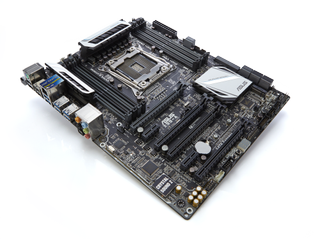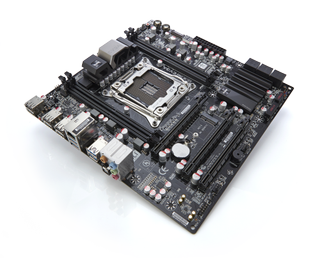X99 motherboard roundup: 7 motherboards reviewed

Asus X99-A
Socket: Asus OC Socket
Size: ATX
Graphics: 3x PCIe 3.0 x16, 1x PCIe 2.0 x16 (max x4 speed)
Multi-GPU support: Up to 4-way CrossFireX/SLI
Memory: 8x DDR4 DIMMs
Storage: 8x SATA 6Gbps, 1x SATA Express (incl. two extra SATA 6Gbps ports), 1x M.2 x4
Back panel: 6x USB 3.0, 4x USB 2.0, 1x PS/2 combo, (more)
The $275 (£203) Asus X99-A is the little brother of the X99-Deluxe and shares much of the same design aesthetic and feature set. Sadly the performance is something that hasn’t been shared. Given the big difference in price that’s not a surprise, but does leave me wondering where the X99-A sits. It’s too expensive compared to the MSI or ASRock bargain-boards but doesn’t offer the full feature-set and performance of either the Deluxe or Gigabyte’s board seen above.
The PCIe storage performance is pretty much the slowest of all these X99 boards, which is a little odd given how speedy the Deluxe is. The stock CPU performance is also relatively low, though that is at least saved by posting the second highest overclocking benchmark. But crucially the framerates are poor on both fronts: the minimums aren’t very good and the average is the absolute lowest of all these boards. (Although that’s still only 7fps off the top performing Gigabyte board.)
It does still offer Asus’s bespoke OC Socket, so it’s the only other board to run Corsair’s 3000MHz XMP setting on its memory modules. But if you are desperate for high-performance memory on a more affordable board, it’s worth mentioning that there will be some X99 revisions happening next year which ought to address the current memory failings. So you don’t have to make do with the X99-A.
Score: 78
Verdict: A capable board with a decent feature set, but doesn’t quite match the gaming performance of the other boards here.

ASRock Fatal1ty X99 Killer
Socket: Intel LGA 2011-v3
Form factor: ATX
Graphics: 3x PCIe 3.0 x16
Multi-GPU support: Up to 3-way AMD CrossFireX/Nvidia SLI
Memory: 8x DDR4 DIMMs
Storage: 10x SATA 6Gbps, 1x eSATA, 1x M.2 x4
ASRock has tried to make the $230 (£208) Fatal1ty X99 Killer as high-spec as possible,creating a board that’s able to post performance figures that are actually only a touch behind the Asus Deluxe. What it can’t do is match even the lower-end Asus board’s overclocking or memory performance. Without that OCSocket to help deliver higher benchmark numbers and improved DDR4 support, it’s difficult to recommend anybody else’s board as a high-end alternative.
The CPU performance is relatively high compared to the others, and the PCIe storage speeds are also impressive, but the X99X Killer is still not going to be the board I’d choose at any level. Compared with the MSI SLI Plus,or even its own X99M Extreme4 stablemate, the Killer can’t deliver much more than either of those two bargain-priced boards.
PC Gamer Newsletter
Sign up to get the best content of the week, and great gaming deals, as picked by the editors.
That’s a shame, as it still gets many things right. The BIOS screen is clear and informative and makes tweaking your system as simple as you could wish. There’s also a Multicore Enhancement option which allows you to eschew Intel’s limitations on running all CPU cores at maximum turbo.
Score: 77
Verdict: This ASRock motherboard puts up good numbers, but it's more expensive than some other options that perform just as well.

EVGA X99 Micro
Socket: Intel LGA 2011-v3
Size: Micro ATX
Graphics: 3x PCIe 3.0 x16 (third slot x8 only)
Multi-GPU support: Up to 3-way AMD CrossFireX/Nvidia SLI
Memory: 4x DDR4 DIMMs
Storage: 6x SATA 6Gbps
The obvious competition for this micro board is ASRock’s Extreme4, but that’s a comparison that doesn’t work out too favourably for EVGA.
The $245 (£200) EVGA X99 Micro keeps up in terms of the featureset, dropping four memory slots but retaining quad-channel compatibility, and it’s also got multiple PCie 3.0 lanes for up to three-way SLI or CrossFireX. Where it’s missing out is in modern storage options.
The biggest omission is the lack of an M.2 slot for PCIe SSDs—the Key E socket is for mini PCIe WiFi cards only. There are also fewer SATA 6Gbps ports. That said, given that PCIe storage is in its infancy you can understand why it wasn’t included.
The issue is that when you’re spending this sort of money you want all the key features to be in evidence. If you’re buying the X99 as a future-proof platform the X99 Micro falls a little short.
It does perform admirably in the benchmarks, aside from DDR4 performance. In gaming it’s right up there with the big guns in terms of average framerate and is the most power efficient of the lot. But when the price is so close to the mATX Extreme4 there’s no good reason to go for this EVGA.
Score: 74
Verdict: A few missing ports and features make this a tough recommendation over similarly priced options.
Benchmarks
Intel Core i7-5960X Cinebench R10 Index score (higher is better)
| X99 motherboard | Cinebench R10 Index score |
|---|---|
| MSI X99S SLI Plus | 1317 |
| ASRock X99M Extreme4 | 1309 |
| Asus X99-Deluxe | 1321 |
| Gigabyte X99-SOCForce | 1314 |
| Asus X99-A | 1315 |
| ASRock Fatality X99X Killer | 1320 |
| EVGA X99 Micro | 1317 |
Intel Core i7-5960X, Battlefield 4 (1080p), Nvidia GTX 780 Ti (higher is better)
| X99 motherboard | Battlefield 4 (min. fps) | Battlefield 4 (avg. fps) |
|---|---|---|
| MSI X99S SLI Plus | 66 | 92 |
| ASRock X99M Extreme4 | 55 | 95 |
| Asus X99-Deluxe | 58 | 93 |
| Gigabyte X99-SOCForce | 52 | 98 |
| Asus X99-A | 54 | 91 |
| ASRock Fatality X99X Killer | 55 | 96 |
| EVGA X99 Micro | 54 | 96 |
Intel Core i7-5960X maximum overclock (higher is better)
| X99 motherboard | Maximum overclock (GHz) |
|---|---|
| MSI X99S SLI Plus | 4.3 |
| ASRock X99M Extreme4 | 4.4 |
| Asus X99-Deluxe | 4.4 |
| Gigabyte X99-SOCForce | 4.4 |
| Asus X99-A | 4.4 |
| ASRock Fatality X99X Killer | 4.4 |
| EVGA X99 Micro | 4.3 |
Page 1: Introduction to X99 motherboards
Page 2: MSI X99 SLI Plus, Asrock X99M Extreme4, Asus X99-Deluxe, Gigabyte X99-SOCForce
Page 3: Asus X99-A, Asrock Fatality X99 Killer, EVGA X99 Micro, benchmark scores

Dave has been gaming since the days of Zaxxon and Lady Bug on the Colecovision, and code books for the Commodore Vic 20 (Death Race 2000!). He built his first gaming PC at the tender age of 16, and finally finished bug-fixing the Cyrix-based system around a year later. When he dropped it out of the window. He first started writing for Official PlayStation Magazine and Xbox World many decades ago, then moved onto PC Format full-time, then PC Gamer, TechRadar, and T3 among others. Now he's back, writing about the nightmarish graphics card market, CPUs with more cores than sense, gaming laptops hotter than the sun, and SSDs more capacious than a Cybertruck.
Most Popular

